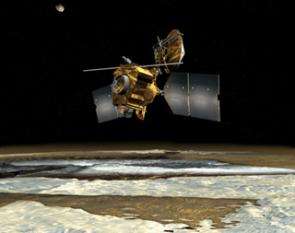HiRISE Camera Will Take First Close-Up Pictures of Mars Sept. 29

The most powerful camera ever to orbit Mars will get its first close look at the Red Planet on Friday. The High-Resolution Imaging Science Experiment (HiRISE) camera flying aboard NASA's Mars Reconnaissance Orbiter (MRO) will relay its first low-altitude images to scientists at The University of Arizona beginning Sept. 29.
"It's exciting because it's the first time we'll see Mars while the spacecraft is orbiting at about 300 kilometers (roughly 190 miles) above the planet's surface," HiRISE principal investigator and UA Professor Alfred S. McEwen said.
The HiRISE camera is the most powerful telescopic camera ever sent to another planet. The camera took its first impressive test images of Mars when it was as far as 2,500 kilometers (roughly 1,600 miles) away from the planet last March, just before MRO began "aerobraking." Aerobraking involved sending the bus-sized spacecraft through Mars' upper atmosphere 426 times between early April and Aug. 30. The technique successfully lowered MRO close to its final science orbit. This maneuver would have required an extra 600 kilograms (1,300 pounds) of fuel if thrusters had been used.
The spacecraft fired six thrusters to reach final science orbit on Sept. 11. The orbit crosses near Mars' north and south poles at altitudes ranging from 250 kilometers (155 miles) to 316 kilometers (196 miles) above the surface.
The HiRISE team has been working at top speed to prepare for the low-orbit images they'll get between Sept. 29 and Oct. 6.
"What makes these next test images exciting for our team is that this time, our effective resolution (sharpness) will be 10 times better," said HiRISE Operations Center (HiROC) manager Eric Eliason. "We're going to see some tremendous detail."
The Sept. 29 - Oct. 6 observing opportunity will be the first time that MRO will use the onboard targeting algorithm and procedures that point the spacecraft at their desired targets. The check-out is designed to test all the observing modes so that there is a smooth start to the primary science phase in November.
"The north polar cap and the Phoenix Mission landing region are our big priority targets for the early science phase, and so we've included them on our targeting check-out," McEwen said.
The NASA Scout-class Phoenix Mission is an international lander mission led by UA's Peter Smith. It is slated for launch in August 2007 for a May 2008 touchdown in Mars' north polar region.
"HiRISE's best chance for photographing candidate Phoenix mission landing sites is in October and November because the sun is getting lower as northern Mars moves into fall," McEwen said. Fogs and hazes will likely degrade viewing by early 2007, he added.
Other imaging targets include about 40 other locations which sample a wide variety of landscapes. The HiRISE team plans to get its first image on Sept. 29 of Ius Chasma, a complex floor that is part of Valles Marineris, a giant canyon system far larger than Arizona's Grand Canyon.
Engineers will turn off the HiRISE camera for a solar conjunction that starts the second week of October. Solar conjunction is when the sun is aligned between Earth and Mars. It will obstruct communications with the spacecraft for about three weeks.
NASA's Mars Reconnaissance Orbiter, launched August 12, 2005, will provide more science data than all previous Mars missions combined. Among its many objectives is a search for evidence that water persisted on the surface of Mars for a long period of time. Other Mars missions have shown that water flowed across the surface in Mars' history. But whether water was ever around long enough to provide a habitat for life remains a mystery.
The HiRISE team uses ISIS-3 software developed and maintained by the U.S.G.S.-Flagstaff for processing its images at HiROC. HiROC is located in the C. P. Sonett Space Sciences Building, 1541 E. University Blvd, on the UA campus.
Source: University of Arizona





















